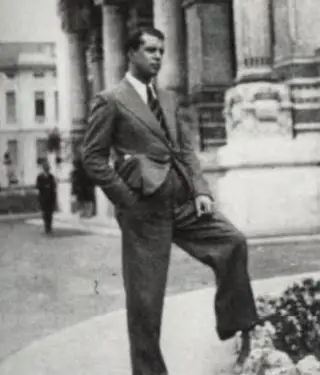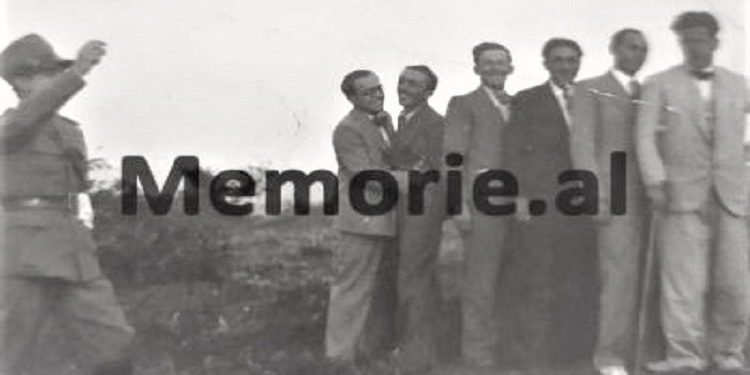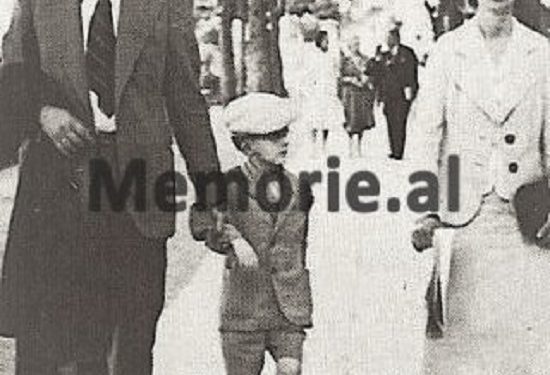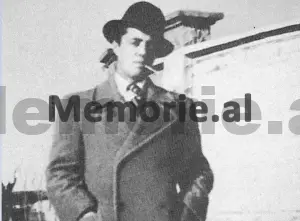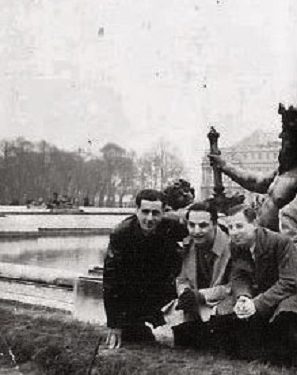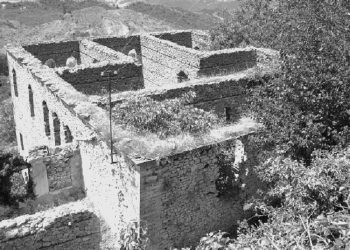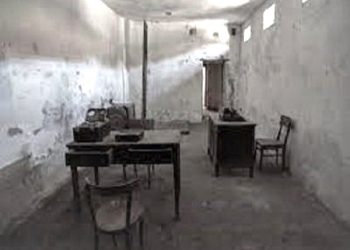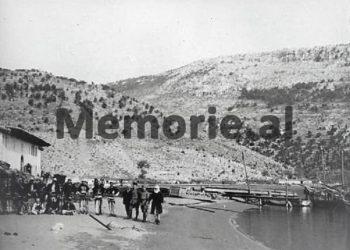By Luan RAMA
Memorie.al / When he stopped at “Carrefour de l’Odeon”, he took a long look at the square, where two streets separated, going up: “Rue de l’Odeon” and “Rue Monsieur le Prince”. Opposite, the publishing house, where the first editions of “Ulysses” by James Joyce, in the French language, were once printed. After fifty-seven years, Hasan Jero, the former medical student, that fall of 1993, was climbing the “Monsieur le Prince” road again. Now his eyes held longing, even more than longing. Next to the new street name plaque, there was still the old plaque that read “Rue des Fosses Monsieur le Prince”, thus commemorating the former Prince of Conde, Henri II of the Bourbons. They were the same old houses, with wooden beams and stone carvings.
It was also the portal of the Hotel de Bacq, built in the 1750s. Above, where the classical building of the “Lycée Saint Louise” or “Collège d’Harcourt” stood, built since the 1280s. “Rue Racine” started from the theater of “Odeon” or “Thèatre de l’Europe” and cut “Monsieur Le Prince” street in the middle.
A little further, the writer George Sand used to live with her family and a few doors away, the sociologist Auguste Le Comte, who was written about at length, in the Albanian newspaper “Illyria”, from the 30s. In the “Le Petit Prince” cafe, the doors were closed and there was almost no one there. Few people passed by the houses where the philosopher Blaise Pascal once lived and next to number 49, the famous English poet, Longfellow.
ENVER HOXHA’S FRIEND, PEOPLE’S POWER ENEMY
Hasan Jero stopped in front of the building where he had lived for several years as a student. Here, up there, on the third floor, where the windows fell on the street, he had lived his most beautiful youth. When he went up to that old hotel, because it seemed to him that everything was happening as it had been sixty years ago, he said he was back from summer vacation, to start school again. Four students lived in those two rooms at that time, but dozens of other students gathered there.
Under the windows, almost opposite, was the “Samuelian” bookstore, opened by an Armenian, some ten years ago, which sold books from the world of the Orient, Turkey, Persia, Greek and Albanian civilization. He still had those old pictures from his student days. In some of them, they appeared in the background of the “Eiffel” tower or on the banks of the Seine. In the afternoon, they went down to the “Latin Quarter”, where there was a small restaurant of a neighborhood named Llazar. “On se voit chez Lazar”, they often said.
At that time in Paris, there were a lot of political immigrants, like; Col. Tromara, Ali Këlcyra, Qazim Koculi, Sejfi Vllamasi, Rexhep Mitrovica, etc. One day in 1933, a young, handsome guy had arrived at the “La Princesse” hotel. His name was Enver Hoxha and he was from Gjirokastra. He came to his friend, Qemal Karagjozi, with whom he had known since the time of Korça High School. At that time he lived there, together with other friends, such as the medical student, Remzi Fico, etc.
The boy came from Montpellier, the south of France, where he had left his studies at the “Faculté des sciences naturelles”, while now he wanted to enroll in the Faculty of Law of the Sorbonne. “I remember quite well, when Enver Hoxha came, – recalled Hasan Jero, and then a student of dentistry in Paris. – We stayed on the second floor of the hotel, at 65… ‘Rue Monsieur le Prince’. I also remember an old woman from Limousin, Madame Agré. Sometimes when we played cards, the old woman came with us, that are me Qemali and Enveri.
Then we would sing the song and the surprised old woman would ask us what song it was. Then came Mendu Angoni, an antizogist, who in Vienna had participated in the assassination attempt against King Zog. Mrs. Agré refused to take the money and put it there, with us. Sokrat Mio, at that time lived not far from us, in a hotel in the “Latin Quarter”. We celebrated the 28th of November at the embassy, while when we wanted to dance; we went to the “Closerie de Lilas”, a large hall called “Salle Bullier”.
At that time, we were about 80 Albanian students, not a few. Our favorite places were the theaters and squares of “Odeon”, “Comedie Française”, cinema halls, where we watched the films of Marcel Pagnol, Remy, Victor France, Charles Vanel or Harry Boor in the wonderful film; “Wretches”. In 1934-1935, when we had just arrived, workers’ demonstrations had broken out in Paris. One day a rifle burst and dozens of workers were killed. The police caught us because we were in line with the workers. We were on the left.
Then they released us. Soon the government would fall and from power, in 1936, Leon Blum and the socialists of the “Popular Front” would come. We read a lot of left-wing newspapers such as L’Humanité, Temps, the government’s mouthpiece, Oeuvre, a newspaper of socialist radicals, directed by Mrs. Tabuy, or Le Canard Enchainée. Then from Moscow, the student Llazar Fundo, a very charming guy, came to us. We heard that he read a lot and was a “mouse” of libraries.”
Hasan’s memories were many. He kept a bunch of photos, until the end of his life, where the Albanian students, his friends, stood out, like; at the ‘Eiffel’ tower, in the Trocadero, in the gardens of Luxembourg, in Paris; or outside Paris; on their excursions; to spend Sundays. After the war, Jero; he did not think that Enver Hoxha, that fragile student, who had never finished his university studies, neither in Montpellier nor in the Sorbonne, would one day become the leader of Albania.
With special nostalgia, he remembered those first years after the war, full of hope and desire, to build the new Albania. “I remember lieutenant Cochet, sent by the French government, he told me in his house, sitting on a minder. – He worked hard for democratic Albania. He often played tennis with Jusuf Vrioni. I also remember Commander Visdorf, a charming man from Alsace, as well as Colonel Tessier…! But our hope came and went.”
After the trial against the deputies, who were for a democratic Albania, like other Western European democracies, it was his turn to try the terrible cells of the Stalinist Albanian prisons. A long ordeal, which would start from Tirana prison, to labor camps and terrible prisons, such as; in Bulqiza, Torovicë, Spaç, Ballsh, Borsh, Zejmen…! “Je suis arrété le 15 mai 1947, – Hasani told me in French, – C’était la période où il eut une espèce de rafle générale dans toute l’Albanie… le 15 et 16 mai 1947″.
At first, he was sentenced to seven years in prison, and then inside, they sentenced him to another fifteen years…”! In fact, some of the former students of France were condemned by Enver Hoxha. Enver Sazani, the independent MP, was shot together with other MPs and buried in a secret grave at the foot of the Dajti Mountain. He had known many of the convicts himself, in France.
In 1945, – Jero continues to remember, – Nedin Kokona, who had completed his law studies at the University of Toulouse, was condemned as an “enemy of popular power”. Andrea Xega, who had studied mining engineering in Saint-Etienne and Paris, was sentenced to death in 1948. In prison, I met many of our friends who had been students in France”.
RETURN TO FRANCE
He had hoped for everything in those cells, except for one thing he had not dared to dream: that he would return one day, to “Rue Monsieur le Prince”. This seemed impossible to him, like a very distant star in that dark galaxy, whose light should have been extinguished long ago. However, he knew that other Albanians should still stay in “Rue Monsieur le Prince”. He knew that that road, which went up and met “Café de Luxembourg”, in front of “Les Jardins de Luxembourg”, was one of the most favorite places of Albanians.
And in fact he was not wrong. In the fifties, there were some political emigrants who settled in that old hotel “Hotel la Princesse”. One day, in a conversation with the immigrant Sabaudin Dino, he spoke to me longingly about those years after the Second World War, when Albanians, mostly political immigrants, gathered there on that street and in the nearby cafe. “At that time,” Dino said, “Jusuf Begeja, Hajredin Hallulli (who at that time worked at the Citroen automobile company), Sefedin Çollaku, etc. lived in that hotel.
All three of them had graduated from the Military Academy in Italy. But other intellectuals and ordinary people also came, such as: Dhori Mihali, who had finished the Lyceum of Korça and then studied medicine in Lyon, doctor Nočka, who soon fled to America, Murat Kallulli from Delvina, as well as doctor Harxhi. Nuçi Kota, who had a studio near the “Pantheon”, was involved in publishing an immigration newspaper. But, from the mid-50s, he and many others fled to America. However, Albanians continued to gather at “Café Luxembourg”…!
One summer day in 1996, when I returned to Tirana, I went to meet Hasan Jero, who was already living in a small alley, near the old National Library. He was sick, but he was very happy that I went to see him. On the wall, he had placed in a frame the glorious appeal of General De Gaulle from London, addressed to all the French, to start the liberation war: “A tous les Français!” “I heard the general’s appeal in Tirana, from BBC Radio.
In that great mourning, under Mussolini’s iron hoof, General De Gaulle’s call was like a flash in the pan. Our hearts were full of hope.” Jero, all his life, considered himself a Gaullist, since in 1940, when he was in Rome, he went to the French embassy, to register to go to France as a volunteer, and to fight against the Nazis. “Then they gave us some red cards, where it was written that we were volunteers”, he recalled.
– Ymer Dishnica, who had studied medicine, in June 1940, left Lyon and came to Paris to join the French resistance”. Elder Jero was happy and started writing his memoirs. When I told him about ‘Rue Monsieur le Prince’, his eyes lit up and immediately he took out that bunch of photos of Paris, which he kept as the most precious things and where together with his Albanian friends, they were photographed near the ‘Sacre-Cœur’ , or at ‘Butte de Chaumont’…! “Here, this one here is Xhevdet Asllani, this one over there, Xhavit Gjata. Then Nazmi Suleimani, Hobdari…”!
The story of this noble man from Leskovica was boring. A year later, when I was going to ask about Hasan Jero, I was told that he had just died. At least he died happy! – I whispered to my friend. Memorie.al




